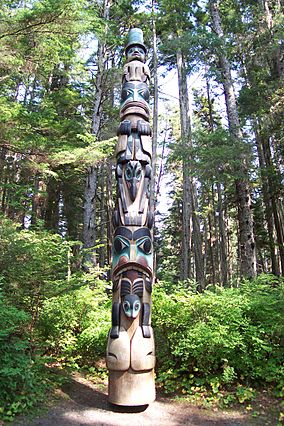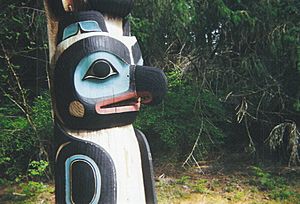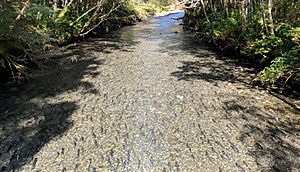Sitka National Historical Park facts for kids
Quick facts for kids Sitka National Historical Park |
|
|---|---|
|
IUCN Category V (Protected Landscape/Seascape)
|
|

|
|
| Location | City and Borough of Sitka, Alaska, USA |
| Nearest city | Sitka, Alaska |
| Area | 112 acres (45 ha) |
| Established | October 18, 1972 |
| Visitors | 186,864 (in 2011) |
| Governing body | National Park Service |
| Website | Sitka National Historical Park |
|
Sitka National Historical Park
|
|
| Location | 106 Metlakatla Street, Sitka, Alaska |
| NRHP reference No. | 66000164 |
| Added to NRHP | October 15, 1966 |
Sitka National Historical Park is a special place in Sitka, Alaska. It was once known as Indian River Park and Totem Park. This park helps us remember important parts of history. It tells the stories of the native Tlingit and the Russians who came to Alaska a long time ago. The park became a national historical park on October 18, 1972. Before that, it was a national monument.
Contents
A Look Back: The Park's History
The story of Alaska's oldest cultural and historic park began on June 21, 1890. On that day, President Benjamin Harrison set aside land for public use. This land was the site of a Tlingit fort called Shis'kí Noow, which means "Sapling Fort."
The Battle of Sitka
This fort was near the mouth of the Indian River. In 1804, it was the location of a big fight. The native Tlingit people fought against Russian fur hunters and their Aleut allies. This event is now known as the Battle of Sitka.
Collecting Totem Poles
From 1903 to 1905, Governor John G. Brady started collecting totem poles. He brought them from all over Alaska to display at the park. Most of these poles came from Haida villages on Prince of Wales Island. Some had even been shown at a big fair called the Louisiana Purchase Exposition in 1904.
Soon after, people in Sitka worried about the park. They saw vandalism and the poles were getting damaged. They asked the government to make the site a national monument.
Becoming a National Monument
On March 23, 1910, President William H. Taft officially declared it the Sitka National Monument. This was done under the Antiquities Act. The goal was to protect the fort site and the valuable totem pole collection.
When the National Park Service was created in 1916, they took care of the monument. Today, many of the poles you see along the park's two miles (3.2 kilometers) of trails are copies. The original, older poles are kept safe in storage. The park is also home to giant Sitka spruce trees, ferns, shrubs, and flowers. If you visit during spawning season, you might even see Salmon swimming up the Indian River!
Changes Over Time
The 112-acre (45-hectare) park was used by the U.S. Army in 1942 for defense. During this time, a lot of gravel was removed from the river and shoreline. This caused environmental problems that lasted for many years. The park was returned to the Department of the Interior in 1947.
In 1965, a new visitor center opened. This was the park's first real building for visitors. It has exhibits and shows where you can watch Alaska Native artists create crafts. The park was added to the National Register of Historic Places in 1966.
Celebrating Native Culture
In 1969, the Alaska Native Brotherhood took over the art demonstration program. They focused on the cultural arts of Southeast Alaska Native people. The Southeast Alaska Indian Cultural Center celebrated its 30th anniversary in January 2000. Many amazing Tlingit artifacts in the park's collection were loaned or given by local families. This helps keep their traditions alive.
The Russian Bishop's House
About half a mile from the main park area is the Russian Bishop's House. It was built between 1841 and 1843 using local spruce wood. Tlingit workers built it, guided by Finnish builders. This house is one of only a few examples of Russian Colonial Style architecture left in the Western Hemisphere.
Who Lived There?
Bishop Innocent (Ivan Veniaminov) of the Russian Orthodox Church lived here until 1853. He was a clergyman, teacher, and linguist (someone who studies languages). The Church used the building as a school, home, and church for another 100 years. By 1969, it was in bad shape and was sold to the National Park Service in 1973.
Bringing it Back to Life
In 1973, the Park Service started a 16-year project to restore the house. They wanted to make it look like it did in its glory days. Modern plumbing, heating, and electricity were added, but they made sure the building still felt authentic. The second floor was restored to look exactly as it did in 1853. This was done using old diaries, drawings, and things found by archaeologists.
Today, you can see many exhibits and beautiful icons in the Chapel of the Annunciation. These show the history of Russian America. The Russian Bishop's House is a National Historic Landmark. Both it and the main park area are listed on the National Register of Historic Places.
See also
 In Spanish: Parque histórico nacional de Sitka para niños
In Spanish: Parque histórico nacional de Sitka para niños





